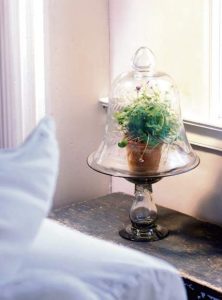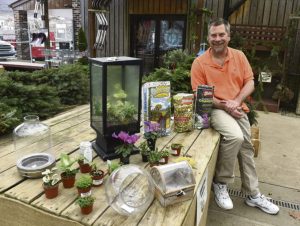Terrariums can be a treat for gardeners when the weather turns cold
Posted on: November 20, 2018 | Written By: Doug Oster |
Tovah Martin actually coined a new word when discussing terrariums. “Orchids look swank anyway; put it in a terrarium, and it looks like a million. It’s just elevated to another level of swankity.”

An example shown in Tovah Martin’s book, “The New Terrarium.”
Martin has planted terrariums most of her life, starting with science experiments as a child. As an adult, she has taken them to a new level in her Roxbury, Conn., home. The author of “The New Terrarium” sees great advantages to planting this way.
“You can grow plants indoors and give them a sparkle, and they will look absolutely ravishing. Why would you not want to do that?” she asks.
Terrariums are clear containers for growing plants. They can be a completely closed system or have a opening. They are a controlled environment for the plants under glass.
“In much less than ideal conditions, you can grow houseplants,” Martin says of terrariums.
She prefers to search out varieties that enjoy high humidity and stay small, like ferns, mosses, orchids, begonias and peperomias. Many foliage houseplants would work, as long as they won’t grow out of control. Most could be trimmed if needed, though.
For Martin, terrariums are much more than utilitarian containers for plants. She wants gardeners to stretch and have fun.
“Plant a little scene and access your inner gardener,” she says. “This is the smallest garden you’re ever going to plant. It’s your little expression. Do it your way.”
Her terrariums are personalized. Besides the greenery, they are filled with bunnies and goats, two things she loves. But Martin also enjoys including tiny items she finds on nature walks, filling her pockets with little lichen-covered sticks or interesting stones earmarked for a minuscule Stonehenge.
It’s imperative the terrarium be located in indirect light, she says.
“It will bake like a car if left in full sun,” she says.
There’s yet another positive for terrariums, she says: “It’s a way to keep plants away from the kitty.”
Terrariums gaining popularity
At Chapon’s Greenhouse in Baldwin, greenhouse manager Matthew Hirsh says he’s seen interest in terrariums explode in recent years.
Hirsh says layering three materials for planting is important for any terrarium.
“I like to use a little river gravel,” he says, “then a thin layer of charcoal, and then you’re going to add your pre-moistened potting soil to it.”
The gravel provides drainage and is about an inch deep. A thin layer of charcoal filters the water in this closed system. To get the planting mix to the right consistency, slowly add water until the mix sticks together but is not dripping. Hirsh uses a light planting mix called Gardener’s Gold.

Cyclamen is a great blooming plant to use in terrariums.
He likes to use tropicals that enjoy lots of humidity. Many are small houseplants like ficus, ferns, ivy, baby’s tears, cyclamen, dieffenbachia and even a Venus fly trap. But Hirsh also recommends succulents for terrariums, like cactus, string of pearls, flowering kalanchoe and one he knows kids will enjoy: a spoon jade plant commonly called ‘E.T. Fingers,’ which does indeed look like its namesake.
“These are all plants that thrive with neglect,” he says. “It all comes down to moisture management.”
Terrariums are a way for just about anyone to garden, he says, like people who don’t have gardening space outside and still want to do something with plants.
“It’s great for apartments or indoors. It’s a great project for kids; we see a lot of grandparents doing this with grandkids,” he says. “This is a great wintertime activity.”
The nursery is filled with a variety of terrariums to fit any home, and there are other containers that will work, too, he says.
“The containers can be as elaborate or as simple as you like,” he says. “Fish bowls, old aquariums, large wine glasses, even a mason jar — anything your imagination can think of.”

Matthew Hirsh, greenhouse manager for Chapon’s Greenhouse, sells material to create a terrarium, but he says other containers work well, too.
Martin has a few other suggestions about planting and caring for terrariums. When planting, be sure to firmly press into the soil to eliminate air pockets and get good contact between the roots and the planting mix. The “tug test” makes sure things are planted right.
“Give it a little tug. If it starts to pull out, you don’t have it firmed-in enough,” she says.
After planting and a light watering, watch for condensation on the glass over the next couple days to make sure the moisture is right in the terrarium. That means things are working the way they should. In 10 days or so, let the container breath by letting some air in. Close it back up; if the condensation returns, things are good. If not, just add a little water.
“It’s actually very low maintenance,” she says. “You only have to water it once every two weeks at the most.”
Terrariums are fun, easy and, most of all, can be a wonderful way to create something interesting and personal.
“It’s a different way to garden,” Martin says. “To me, it’s very beautiful; it looks more like an art form.”
Editor’s note: This story was originally published on Jan. 7, 2016.
More from Everybody Gardens